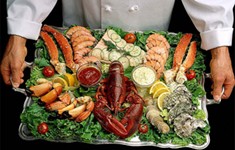 Growth in China’s consumption of aquatic products is outpacing growth in production of such products, according to an agricultural ministry researcher in Beijing in documents provided to Seafoodsource by the ministry.
Growth in China’s consumption of aquatic products is outpacing growth in production of such products, according to an agricultural ministry researcher in Beijing in documents provided to Seafoodsource by the ministry.The shift to urbanization of rural residents is driving consumption among previously low-level consumption segment of society, said Zhang Yumei, a fisheries specialist at the Agriculture Information Institute at China’s Academy of Agricultural Sciences, the ministry’s main think tank.
Zhang claims that China’s consumption of aquatic products, at 16.5 million metric tons (MT) (compared to 7.56 million MT in 2000), represents 30 percent of the country’s total aquatic output, and at a growth rate of 5.71 percent is growing significantly faster than overall output of aquatic products. Rising at an average 3.83 percent a year between 2000 and 2011, growth in China’s seafood output has slowed from the highs seen in 1980-90 (10 percent a year) and 1990-2000 (6 percent).
In his recently compiled report on consumption and output trends Zhang predicted rising incomes and increased spending on dining out by Chinese consumers will further drive the pace of consumption. He suggested government “put particular emphasis on improving management of freshwater fisheries resources” — where Zhang sees greatest scope for increased fisheries output — while also increasing spending on research and development across the industry.
Higher incomes and urbanization are obvious drivers of China’s growing taste for seafood. Data shows rural consumers eating 5.36kg in 2011, compared to just 3.82kg a year in 2000. By contrast the country’s urbanites were eating 14.62kg in 2011 compared to an average 10.34kg in 2010. Zhang believes the growth of incomes in a more urbanized China — together with a more modest growth in consumption output in rural areas — are both key to understanding future growth in China’s seafood consumption.
Growth in dining out is also a driver. In urban areas the percentage of seafood consumed outside the home rose from 14.70 percent to 21.49 percent between 2000 and 2011, according to Zhang, who also helps compile the China Fishery Yearbook, the standard source of data for official purposes in China. He assumes that the percentage of dining out is approximately the same in rural areas, though average spend is considerably less.
In overall volume terms Chinese ate 3 million MT in 2011 outside the home, compared to 1.15 million MT in 2000, an average per-annum growth rate of 9 percent. Consumption at home amounted to 13.62 million MT, a significant jump on 7.83 million MT in 2000.
Seafood prices have been growing faster than China’s official consumer price index (CPI) and at an average annual rise of 5 percent between 2000 and 2011 have certainly outpaced price growth in other key food items counted in the CPI, such as vegetables and pork. Aquatic prices rose fastest between 2000 and 2011 — jumping 8 percent a year — a rise that may be partly explained by soaring prices for luxury seafood products like sea cucumber.
Faster growth in freshwater capture and aquaculture is good news for inland provinces like Hubei and Jiangxi which have vigorously pushed their aquatic output.





